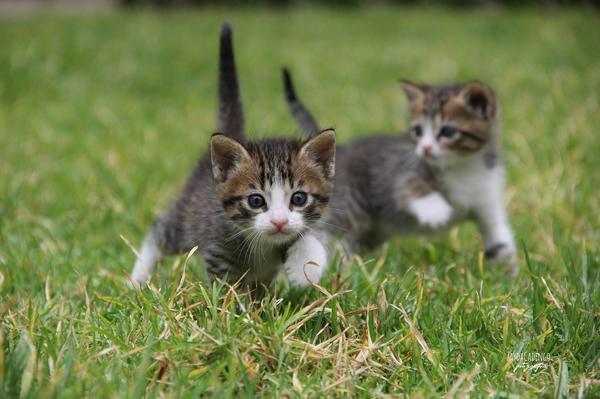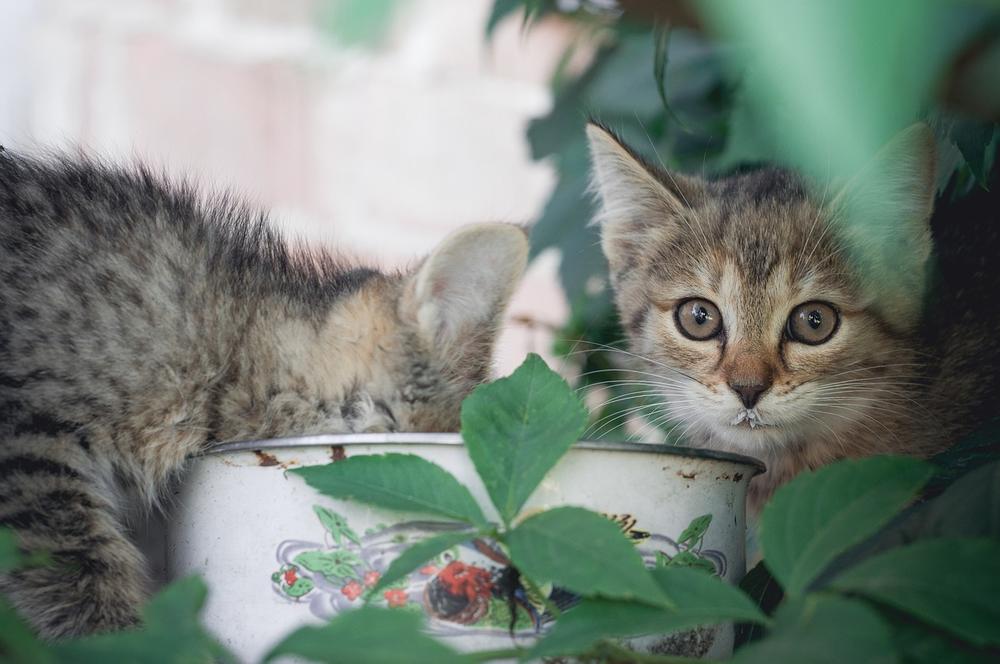When Should I Start Litter Box Training a Kitten? (Answered)

Just imagine:
You've got a brand new, adorable ball of fur in your arms, and your heart is bursting with love. 😍
But between the snuggles and the playtime, a seed of worry starts to sprout.
When do you start teaching your little fluffball to handle their business in a litter box?
Don't fret, my concerned caretakers.
I've got your back.
Let's unravel this purr-fectly timed journey together.
Buckle up, because it's time to find out when to start litter box training kittens.
Let's dive in, shall we?
When to Start Litter Box Training Kittens
When it comes to litter box training kittens, timing is everything.
And let me tell you that you should start the training process when your little furballs are around 4 weeks old.
That's a good age for them to start learning how to use the litter box like big cats.

However, bear in mind that if your kittens are younger than 8 weeks, they might need some extra help from yours truly during this time.
You see, at such a young age, their little bodies and brains may not be fully developed yet, which can make things a bit challenging.
But don't worry, I've got some tips to make this whole training process as smooth as possible for you and your kittens:
- Choose a shallow litter box filled with nonclumping litter to start. Kittens may find larger litter boxes intimidating at first.
- Place the litter box in a quiet and accessible location, away from their sleeping and eating areas. Just like us, kittens appreciate privacy when using the litter box!
- Gently place the kittens in the litter box after meals or naps to encourage them to associate it with bathroom time.
- Keep the litter box clean and fresh by scooping out waste regularly and replacing litter as needed. Nobody likes a dirty bathroom!
With these tips, you'll have your kittens well on their way to becoming litter box pros in no time.
Happy training! 😺
Main points I'll expand upon further down this article:
- Start litter box training kittens at around 3 to 4 weeks old.
- Take your kitten to the vet to rule out any medical issues.
- Confine kittens to one room to help them find the litter box.
- Place a litter box in a location where the kitten frequently eliminates.
- Show the kitten how to use the litter box by gently placing them in it.
- Use pheromone diffusers near the litter box to relieve stress.
- Clean the litter box at least once a day and reward your kitten for using it correctly.
- Experiment with different types of litter to find what your kitten prefers.
- Choose a safe litter without fragrances or chemicals for your kitten.
- Properly place the litter box in a clean corner away from clutter.
Signs That Kittens Are Ready for Litter Box Training
When it comes to training kittens to use a litter box, there are a few signs that show they're ready.

Look for some sniffing or scratching the ground, indicating that kittens are developing their instinct to eliminate in a specific area.
Around 3 weeks old, kittens begin to grasp the idea of the litter box.
So, if you have a tiny fur ball and you want to teach them about using a litter box, here's what I suggest:
- Before starting the training, take your kitten to the vet. This will help make sure there are no medical issues causing accidents outside the box.
- Wait until they start weaning from their mom and eating solid food, usually around 3 to 4 weeks old. That's when you should introduce them to the wonderful world of the litter box.
- Don't worry, kittens catch on quickly. With a bit of patience and guidance, they'll become litter box experts.
Your little bundle of joy will have the highest likelihood of successfully being litter box trained if you watch for these indications and adhere to these procedures.
Introducing Kittens to the Litter Box
Creating a positive association with the litter box
When it comes to helping your kittens get acquainted with the litter box, let's make sure they have a good experience.
To start, why not introduce some pleasant scents near the litter box?
Kittens love the smell of catnip and it will help them associate the area with something enjoyable.
It's also a great idea to keep your kittens in one room at first.
This way, it's easier for them to find the litter box and reduces the chances of accidents happening elsewhere in your home.
If you notice that a particular spot is frequently used by a kitten, go ahead and place a litter box there. Make it as convenient as possible for them.
Teaching your kittens how to use the litter box
Now, let's talk about introducing the litter box properly.
Gently place the kitten inside and if needed, show them how to paw at the litter.
Don't worry if they don't catch on right away - it might take some time.
Using pheromone diffusers near the litter box can also be helpful.

They can ease any stress or anxiety your kittens may feel during this training process.
Consistency is key when it comes to training kittens.
After they eat or wake up, bring them to the litter box and encourage them to dig into the litter. Show them where the box is and always keep it in the same spot for easy access.
As soon as you bring your kittens home, guide them to the litter box and continue to do so a few times each day. It will help reinforce the box's location and establish good litter box habits.
In cases where your kittens are struggling consistently, it may be necessary to confine them to a small space like a bathroom.
Limiting their access until they regularly use the litter box can reinforce the behavior we want.
And finally, if you're interested in learning how to train a stray cat to use a litter box, I highly recommend checking out my article on this topic.
It provides valuable insights and advice on successfully guiding a stray cat through the litter box training process.
You can find it by following this link: How to Train a Stray Cat to Use a Litter Box.
By following my proven tips and techniques, you can ensure a smooth transition for your new furry friend.
Tips for Successful Litter Box Training
Litter box training is tough, but don't worry, I've got some tips to help you out.
- Keep the litter box clean and scoop it every day. Kittens like things tidy, so a dirty box won't cut it.
- When your kitten does his business in the right place, click and reward him with treats. This way, he'll associate using the box with good things.
- Keep your kitten confined to certain areas until he's consistent with using the litter box. This helps him form good habits and prevents accidents elsewhere.
- Make sure there's about 2 to 3 inches of litter in the box. That's enough for your furry friend to dig around and cover up his mess comfortably.
- Try different types of litter to see what your kitten prefers. Some like clay, while others prefer more natural options like pine pellets or recycled paper.
Never punish your kitten for accidents outside the litter box. Just be patient and adjust things like cleanliness and conditions to make him feel comfortable using it.
With these tips, your kitten will be a pro at using the litter box in no time!
Setting Up the Perfect Litter Box for Kittens
When it comes to setting up a litter box for kittens, here are some simple and practical tips to ensure they're comfortable and clean:
- Give them options: Try out different types of litter like clay, recycled paper, or wood pellets so the kittens can find what feels right to them.
- Choose safe litter: Go for a fragrance-free and chemical-free litter that doesn't clump. Using a natural, pellet-based litter can help prevent any breathing or swallowing problems.
- Keep it accessible: Opt for an open-top and shallow litter box that kittens can easily get in and out of. As they grow, you might need to increase the size of the box.
- Offer choices: When you first introduce the litter box, provide both covered and uncovered options. Let the kittens decide which one they prefer.
- More boxes for multiple cats: If you have more than one cat in your household, it's best to have one litter box per cat. This helps avoid any conflicts or overcrowding.
- Location, location, location: Find a clean corner away from clutter where your kitten hangs out the most. For older kittens, make sure there are additional litter box options within about 10 feet.
- Light it up: Make sure the area around the litter box is well-lit, especially if there isn't much natural light in that spot.
- Separate from food: Keep the litter box far away from their feeding area to maintain cleanliness and hygiene.
- Think vertical: If you have a multi-story house, consider placing litter boxes on each floor so the kittens can easily access them wherever they are.
- Easy cleanup: Put a puppy pad under the litter box to make cleaning up a breeze.
You can create an ideal litter box arrangement for your kittens by adhering to these suggestions, ensuring their training experience is effortless and devoid of anxiety.

And now that you have set up the perfect litter box for your kittens, let's talk about how to approach their training...
Common Mistakes to Avoid When Litter Box Training Kittens
You've got a new kitten and you're ready to train them to use the litter box.
Congrats!
But before you jump in, here are some mistakes to avoid:
- Don't yell or punish your kitten for accidents outside the litter box. It will make them scared of using it.
- Clean up any messes promptly to prevent scent associations.
- Check if the litter box setup is comfortable for your kitten. You may need to change the box or type of litter.
- If training is difficult or your kitten seems uncomfortable, ask a vet for advice.
- Use an enzyme cleaner to get rid of odors and discourage repeat accidents.
- Figure out if there are underlying issues causing litter box avoidance, such as dirty boxes, small spaces, location problems, or medical conditions like urinary tract infections.
- If your kitten still refuses to use the box after a few days, investigate and consider making changes.
- In stubborn cases, schedule a vet appointment for professional advice.
To increase the likelihood of successfully training your kitten to utilize the litter box, ensure you steer clear of these errors.
Good luck!
But what if you've never had to litter box train a kitten before?
Don't worry, I'm here to guide you through the process and help you understand why proper training is so important for your furry friend!
Understanding the Importance of Litter Box Training
When it comes to litter box training, you need to understand its importance. 🐱
Proper litter box training helps prevent behavioral issues that can be a real pain in the kitty's butt.
Cats are naturally clean animals and have an instinct to bury their waste.
This makes litter box training relatively easy for most cats. They happily use the litter box, making cleanup a breeze and keeping their elimination process mentally and physically beneficial.
But sometimes, you may need to train a kitten that has never used a litter box before.
Don't worry, I've got some tips to help you out!
- Start by placing the litter box in a quiet and easily accessible area. Avoid placing it near the cat's food or sleeping area.
- Use a litter that your kitty likes. Experiment with different types until you find the one they prefer.
- Show the kitten the litter box and gently place them inside after meals or naps to encourage them to use it.
- Keep the litter box clean by scooping it daily and completely changing the litter regularly.
- Be patient and consistent with training. It may take some time for kittens to catch on, but they will get there eventually.
Litter box training is an essential part of caring for your feline friend, so stick with it!
And that wraps up today's article.
If you wish to read more of my useful articles, I recommend you check out some of these: Why Does My Cat Play in the Litter Box, Why Is My Cat Hiding in the Closet, Why Do Cats Knock Over Their Food Bowls, How to Find a Lost Cat in Winter, and Do Kittens Bite When Teething
Talk soon,
-Sarah Davis